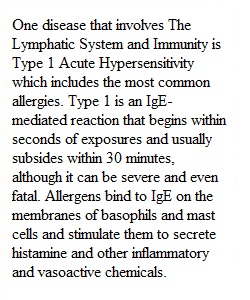


Q Chapter 20 - The Lymphatic System and Immunity (Extra Credit Discussion) In this module, you learned about the Lymphatic System and Immunity. Complete the following five tasks in your original post: 1. Name one disease that involves this organ system. 2. Describe the anatomical and/or physiological disturbance with this disease (In other words, the cause of this disease). 3. Explain signs and symptoms of this disease. 4. Explore possible treatments for this disease. 5. List your resource(s) for this discussion (does not need to be a formal APA citation; a link will suffice). The following requirements must be met to ensure full credit for this discussion (maximum score = 20 points): • You properly address all five tasks above in your original post (1 point for each task = 10 points total) • Your original post should consist of a minimum of 150 words, not including your resource(s) (2 point total) • NOTE: You will not see your classmates' discussion posts until you first complete your own discussion post. • Read the discussion posts of at least 2 classmates and respond to each of them with (1 point for each response = 4 points total): 1. Something you learned about the disease they selected; and/or 2. Extra information you would like to add to the disease they selected • Your feedback to your peers must be a minimum of 50 words each (1 point for each response = 4 points total) ___________________________________________ Example original post for the Muscular System: 1. After studying the muscular system, I chose the disease called Myasthenia Gravis. 2. Myasthenia Gravis is a genetic condition that causes the nicotinic acetylcholine receptor in the neuromuscular junction to be blocked. 3. Patients with this condition may experience weakness in their skeletal muscles, not fatigue. The more they use their muscles, the more the weakness becomes prominent. Therefore, at the end of the day, they experience their muscle weakness greater than at the beginning of the day. In about two-thirds of the population, eyelid drooping (ptosis) may occur due to weakness of the eye muscles. As a result, patients may experience double vision. 4. Treatment may be accomplished through medication and/or surgery. Medically, acetylcholinesterase inhibitors may be prescribed or a steroid medication called prednisone. Surgically, a thymectomy may be performed. Another technique called plasmapheresis may help remove the antibodies from the circulation, but may need to be repeated every few weeks and is expensive. Resource: https://en.wikipedia.org/wiki/Myasthenia_gravis#Signs_and_symptomsLinks to an external site. Example response post to the above post for the Muscular System: I learned that there is a disease in the neuromuscular system that affects the acetylcholine receptor. By blocking the acetylcholine receptor, the transmission of the electrical impulse from the nerve to the muscle would have trouble passing. I researched how the medication of acetylcholinesterase inhibitors would help a patient with this disease. Preventing the degradation of acetylcholine by blocking the acetylcholinesterase enzyme, allows for more acetylcholine to be in the synaptic junction and compete with the autoantibodies blocking the acetylcholine receptor. This allows for more electrical impulse transmission from the skeletal muscle to the nerve to improve muscle strength.
View Related Questions